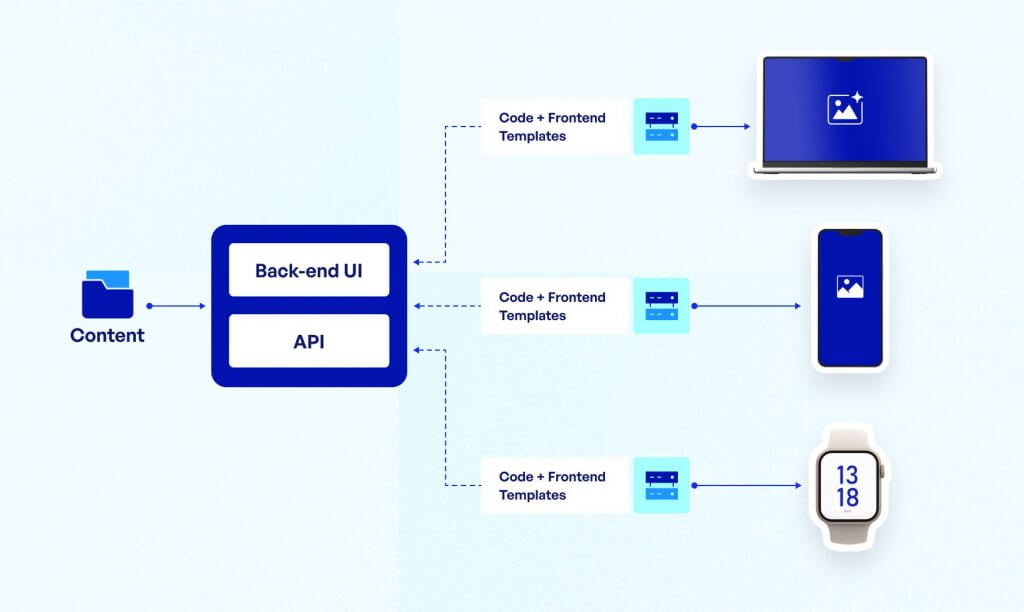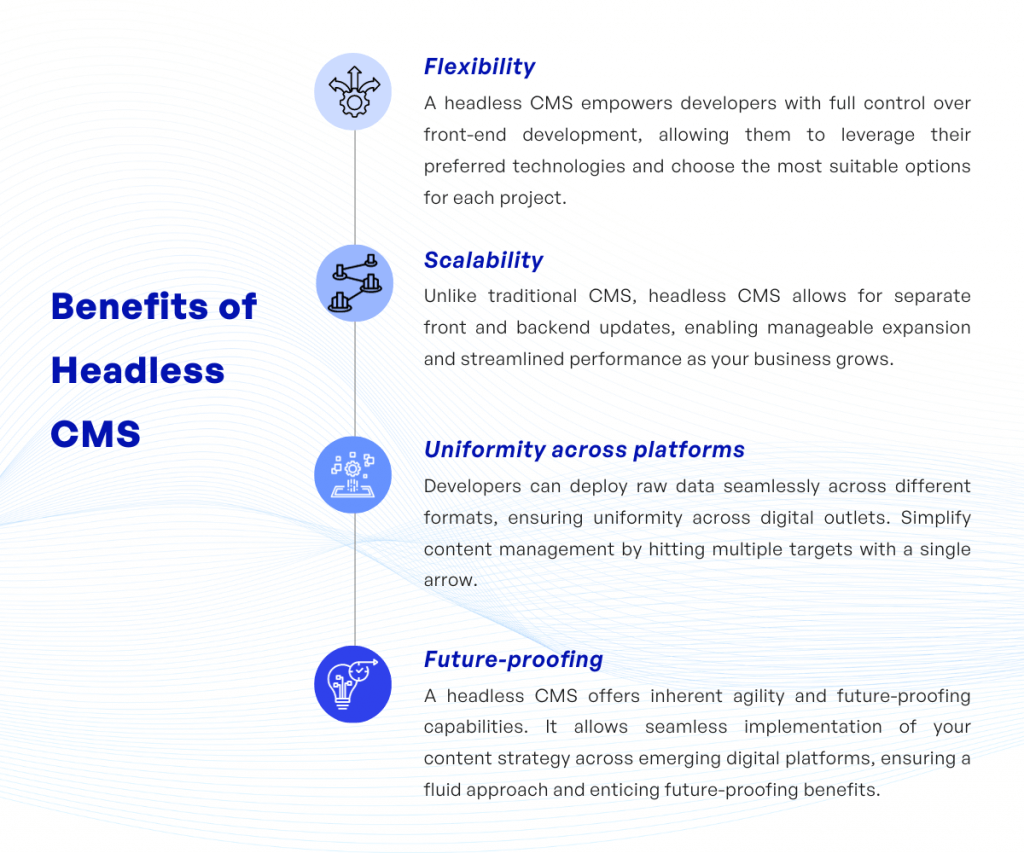
Imagine navigating the digital realm without encountering a single website powered by a Content Management System (CMS). Sounds unlikely, doesn’t it? That’s not without reason: recent data shows that approximately 64% of websites currently use a CMS, carving a colossal chunk out of the contemporary webscape. Now, a rapidly emerging aspect within the landscape is headless CMS, a concept that’s got industry insiders buzzing like bees around a honey pot. But why exactly?
A headless CMS, to put it simply, is a back-end content management system that provides greater flexibility for delivering content. Most noticeably, it separates the content from the presentation layer (the “head”), thus becoming “headless”. This split allows content to be presented anywhere, on any device, because it is delivered via an API as raw data. With a headless CMS, you’re essentially focusing on the preparation and storage of the content, and leaving the display specifics to the device fetching the content.
Jeff Eaton, a digital strategist
“A headless CMS doesn’t care what the output looks like. It’s just responsible for storing and delivering structured content. Anything else — layout, interactivity, visual design — is a paperwork problem that the display layer handles separately.”
This level of engagement and responsiveness is highly sought-after in an era where delivering seamless digital experiences across multiple channels is the modus operandi. It’s not just about serving your audience content anymore; it’s about serving them the right content, in the right format, at the right time. Headless CMS systems make this achievable by providing marketers with the ability to create once and publish everywhere (COPE).
1. Concept of Headless CMS
What exactly do we mean when we talk about a headless CMS? To simplify, a ‘head’ in content management system terminology usually represents the front-end part of the website – the section that users interact with. So, logically, removing the ‘head’, or going ‘headless’, implies a content management system that functions without a front-end layer. In the case of a headless CMS, the system centers around back-end content management, and content is stored so it’s ready to publish on any front-end.
A critical concept linked to headless CMS is API (Application Programming Interface.) The API bridges the gap between the back end of a system, where the content is stored, and the front end, where you want to present the content. It’s the API’s job to retrieve content from the CMS back-end in response to a request. What makes this so powerful? Well, not to overcomplicate the situation, but APIs can communicate with virtually any device capable of sending a request over the Internet.
Probably, you might be wondering, why would you need a headless CMS?
Well, to understand why a headless CMS matters, let’s first consider the digital landscape. Only a decade ago, most online content was viewed on desktop computers. But with the rapid rise of smartphones, tablets, smart TVs, and even smartwatches, the digital consumption landscape has changed dramatically. This digital evolution presents a thrilling opportunity for content creators and marketers to connect with audiences across various platforms.
With a headless CMS, content is not tied down to a specific presentation layer or platform. Instead, it is served via an API and integrated on any platform—a website, a mobile app, a voice assistant, IoT devices— basically, anywhere.
Is it all making a bit more sense now? Each new device and platform that emerges is another potential canvas for you to engage with your audience. And that’s where a headless CMS shines – acting as a multi-platform content hub.
2. Benefits of Headless CMS

Delving into the advantages, let’s dissect why adopting a headless CMS might be the game changer for your digital content strategy. You see, with a traditional CMS, your content and presentation layer are intertwined. While on the surface, this might feel like no big deal, it indeed restrains your business’s potential to scale and adapt in this increasingly digital age. Navigating this intricate landscape is where headless CMS comes into its own, bestowing on organizations a footed system.
You may ask, “How exactly does headless CMS accomplish this?” The answer lies in its intuitively designed structure. Well, let’s delve into the benefits of leveraging this technology.
2.1. Flexibility
Headless CMS leaves the front-end development entirely to the discretion of the developers (remember, it’s headless for reasons). This, in essence, means they can use whatever technology they are most comfortable with or consider most suitable for the project at hand. Do you see the flexibility here?
2.2. Scalability
Another key benefit is scalability. Consider how your needs may change as your business grows. With traditional CMS, scaling can be a complicated process. However since headless CMS separates the front from the backend, changes or updates to one do not impact the other. This segregation allows for more manageable expansion and streamlined performance, even as your business blossoms.
2.3. Uniformity across platforms
You’ve poured countless hours into perfect content. Don’t you want it to be consistent on every platform? With a headless CMS, the same content can be published across all channels without worrying about the layout or how it looks on each platform. The system provides developers with raw data that they can deploy seamlessly across different formats, ensuring consistency across all digital outlets. Think of it as hitting multiple targets with a single arrow – an ability to maintain content uniformity.
2.4. Future-proofing
One of the most compelling advantages of embracing a headless CMS is who knows what the future of digital marketing may hold. Since the CMS is independent of the presentation layer, it is inherently agile.
Therefore, as new digital platforms emerge (as they inevitably will) implementing your content strategy across these platforms becomes less cumbersome and more fluid. Isn’t future-proofing your content strategy an enticing proposition?
In conclusion, navigating a digital world incessantly in flux can be a daunting task. But, with tools like a headless CMS, your organization is well equipped to scale and adapt, reaping benefits in flexibility, scalability, uniformity, and future-proofing. Now, isn’t that transformative?
3. Use Cases of Headless CMS
In a digital landscape that’s as dynamic as they come, a tool like a headless CMS demonstrates its versatility across numerous business scenarios. You might query, “What can one achieve with a headless CMS?” Let’s delve right in.
One powerful use case is content syndication. With a headless CMS, businesses can achieve content harmonization and centralized management. Consider this: you have a blog post that needs to go up on your website, social media platforms, partner sites, and an email newsletter. Instead of the painstaking effort of customizing this post for each platform, the “create once, publish everywhere” mantra, unique to headless CMS, can be your saving grace.
Another potent use case revolves around microsites. More often than not, businesses need to spin up microsites for initiatives like product launches or events. These sites might have a unique design and user experience, separate from your primary website. It’s here where a traditional CMS might become a stumbling block due to its tied front-end and back-end. Conversely, a headless CMS, being front-end agnostic, allows businesses to create these microsites with an unparalleled level of ease and efficiency.
Next, when discussing headless CMS, it’s difficult not to mention its significance for e-commerce businesses. For these enterprises, creating a seamless and personalized shopping experience across multiple touchpoints is essential but challenging. From mobile applications to augmented reality experiences, the shopping journey is no longer connected to a single web storefront. A headless CMS, with its ability to push content across platforms from a single source, serves as a remarkable solution to this complexity. E-commerce businesses can manage their product information, blog content, promotional banners, and more, all within one system, ensuring a consistent and timely user experience across all channels.
These are just a few examples. The versatility of a headless CMS ensures it fits into many other contexts effortlessly. Do you have a unique business problem, and wondering whether a headless CMS is the answer? Chances are, it probably is.
4. Top Headless CMS Platforms in the Market
Are you interested in finding the best headless CMS available in the market? Look no further. We’ve compiled a list of exemplary headless
CMS products that you should consider, each with its unique strengths and capabilities:
- Strapi: This open-source headless CMS holds the advantage of being highly customizable. Its versatile framework empowers both developers and non-technical folks to manage and distribute content flexibly.
- Contentful: Often regarded as one of the pioneers of the headless CMS industry, Contentful provides robust content infrastructure, ease of scalability, and well-documented APIs that integrate with virtually any platform.
- Butter CMS: Butter CMS offers a user-friendly setup and maintenance process. It enables developers to integrate CMS features into their apps with minimal technical overhead.
- Netlify CMS: A powerful open-source CMS, Netlify CMS shines in its simplicity and seamless integration with Netlify’s deployment workflow.
You might be asking yourself, “So, how do I decide which one is right for me?” The choice depends largely on your precise content management requirements, your technical expertise, and the desired level of customization. Let’s delve deeper into the specifics of each CMS:
| Product | Strengths | Best Suited For |
| Strapi | Highly customizable, open-source | Teams seeking a versatile, customizable CMS |
| Contentful | Scalable, well-documented APIs | Large-scale projects requiring robust content infrastructure |
| Butter CMS | User-friendly setup and maintenance | Projects requiring rapid deployment and minimal technical overhead |
| Netlify CMS | Simple, seamless integration with deployment workflow | Teams already using Netlify and seeking an uncomplicated CMS solution |
The best headless CMS is the one that suits your organization’s needs and goals. Understand your requirements deeply before selecting your preferred system.
5. Conclusion
As we broach the conclusion, it should be abundantly clear why the notion of a headless CMS is gaining traction within numerous industries. By divesting content management from delivery, we are presented with a system that is remarkable for its potent combination of broad adaptability and robust scalability. Indeed, few other solutions can match the headless CMS in its capability to deliver seamless experiences across diverse platforms — who wouldn’t lay claim to such a promising prospect?
But let’s not get ahead of ourselves. As with any technology, there are trade-offs. While a headless CMS may offer commanding advantages for certain businesses, it may not be the right fit for everyone. For simpler cases, leveraging a traditional CMS could be more cost-effective. Surely, this is worth pondering: are you ready to take on the best-of-breed approach, combining different tech stacks, and managing multiple vendors? Because this is typically what choosing a headless CMS can entail.
Yet, for those who dare to embrace this innovative approach, the rewards are potentially manifold. Think about it: When has there ever been a one-size-fits-all solution, especially when it comes to the nuanced and multifaceted world of digital content management? Headless CMS integrates the exact components you need for your specific business strategies, without the murkiness involved in deploying a usual CMS.
In final consideration, whether you should switch to a headless CMS really hinges on your unique environments and strategic goals. It’s a matter of matching the strengths and potentialities of this cutting-edge tool with the specific needs of your business – a challenge in itself that requires deep understanding, thoughtful consideration, and yes, sometimes, a daring leap into the future.
If you have any questions regarding headless CMS, feel free to contact KVY TECH.


